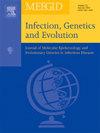Mitochondrial genome analysis across different populations reveals the intraspecific variation and phylogeography of the Caucasian soft tick relapsing fever vector, Ornithodoros (Pavlovskyella) verrucosus (Ixodida: Argasidae)
IF 2.6
4区 医学
Q3 INFECTIOUS DISEASES
引用次数: 0
Abstract
Territories in southern parts of Eastern Europe and in the Caucasus are endemic for tick-borne relapsing fever (TBRF), caused by Borrelia caucasica. This spirochete is transmitted exclusively by the bites of Ornithodoros verrucosus; however, the distribution and genetic diversity of the tick vector have not been explored. To address this, we performed a phylogeographic study of O. verrucosus specimens collected across a large geographic distribution. We sequenced and analyzed complete mitochondrial genomes of 54 individual O. verrucosus ticks representing 23 geographically diverse populations from Ukraine, Georgia, and Azerbaijan. We detected 47 unique haplotypes, with every collection site exhibiting distinct polymorphisms. This, along with other population genetic indices, suggests little evidence of gene flow between populations. The Bayesian coalescent analysis revealed the presence of four lineages that diverged in the Middle Pleistocene (770–126 kya). Two lineages were widespread and present in all study regions, while the other two were restricted to the southern foothills of the Lesser Caucasus mountain range. The sympatry of these ancient lineages suggests that isolation by environment, in addition to geographic distance, may play a role in the intraspecific divergence of tick populations. Using a phylogeographic approach, we provide a snapshot of genetic diversity in O. verrucosus and discuss the evolutionary history of the tick vector.
不同种群的线粒体基因组分析揭示了高加索软蜱复发热病媒 Ornithodoros (Pavlovskyella) verrucosus(Ixodida: Argasidae)的种内变异和系统地理学。
东欧南部和高加索地区是蜱传复发性热(TBRF)的地方病流行区,该病由高加索包柔氏螺旋体(Borrelia caucasica)引起。这种螺旋体仅通过疣蜱(Ornithodoros verrucosus)的叮咬传播;然而,蜱媒的分布和遗传多样性尚未得到研究。为了解决这个问题,我们对收集到的verrucosus标本进行了系统地理学研究。我们对来自乌克兰、格鲁吉亚和阿塞拜疆的 23 个不同地理种群的 54 个 O. verrucosus 蜱个体的完整线粒体基因组进行了测序和分析。我们检测到 47 个独特的单倍型,每个采集地点都表现出独特的多态性。这一点以及其他种群遗传指数表明,种群间基因流动的证据很少。贝叶斯聚合分析显示,在中更新世(770-126 千年)出现了四个分化系。其中两个支系分布广泛,遍布所有研究地区,而另外两个支系则局限于小高加索山脉南麓。这些古老品系的共生表明,除了地理距离之外,环境隔离也可能在蜱种群的种内分化中起了作用。利用系统地理学方法,我们提供了O. verrucosus的遗传多样性快照,并讨论了蜱媒的进化史。
本文章由计算机程序翻译,如有差异,请以英文原文为准。
求助全文
约1分钟内获得全文
求助全文
来源期刊

Infection Genetics and Evolution
医学-传染病学
CiteScore
8.40
自引率
0.00%
发文量
215
审稿时长
82 days
期刊介绍:
(aka Journal of Molecular Epidemiology and Evolutionary Genetics of Infectious Diseases -- MEEGID)
Infectious diseases constitute one of the main challenges to medical science in the coming century. The impressive development of molecular megatechnologies and of bioinformatics have greatly increased our knowledge of the evolution, transmission and pathogenicity of infectious diseases. Research has shown that host susceptibility to many infectious diseases has a genetic basis. Furthermore, much is now known on the molecular epidemiology, evolution and virulence of pathogenic agents, as well as their resistance to drugs, vaccines, and antibiotics. Equally, research on the genetics of disease vectors has greatly improved our understanding of their systematics, has increased our capacity to identify target populations for control or intervention, and has provided detailed information on the mechanisms of insecticide resistance.
However, the genetics and evolutionary biology of hosts, pathogens and vectors have tended to develop as three separate fields of research. This artificial compartmentalisation is of concern due to our growing appreciation of the strong co-evolutionary interactions among hosts, pathogens and vectors.
Infection, Genetics and Evolution and its companion congress [MEEGID](http://www.meegidconference.com/) (for Molecular Epidemiology and Evolutionary Genetics of Infectious Diseases) are the main forum acting for the cross-fertilization between evolutionary science and biomedical research on infectious diseases.
Infection, Genetics and Evolution is the only journal that welcomes articles dealing with the genetics and evolutionary biology of hosts, pathogens and vectors, and coevolution processes among them in relation to infection and disease manifestation. All infectious models enter the scope of the journal, including pathogens of humans, animals and plants, either parasites, fungi, bacteria, viruses or prions. The journal welcomes articles dealing with genetics, population genetics, genomics, postgenomics, gene expression, evolutionary biology, population dynamics, mathematical modeling and bioinformatics. We also provide many author benefits, such as free PDFs, a liberal copyright policy, special discounts on Elsevier publications and much more. Please click here for more information on our author services .
 求助内容:
求助内容: 应助结果提醒方式:
应助结果提醒方式:


